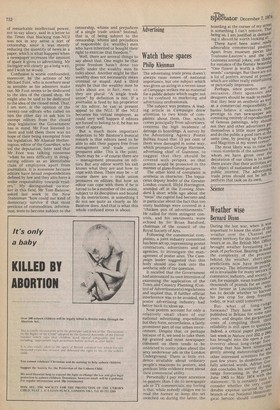Advertising
Watch these spaces
Philip Kleinman
The advertising trade press doesn't always raise issues of national importance, but one subject which was given an airing in a recent issue of Campaign strikes me as material for a public debate which ought not to be confined to marketing and advertising professionals.
The subject was posters. A leading article in Campaign drew attention to two kinds of complaints about them. One, .which comes principally from advertisers, concerns the high incidence of damage to hoardings. A survey by the Advertising Agency Poster Btireau found that 13 per cent of them were damaged in some way, which prompted George Harrison, advertising chief of Guinness, to suggest that they should be covered with perspex, so that posters would be protected in the manner of glass-framed pictures.
The other kind of complaint is aesthetic in character. The loquacious deputy leader of the Greater London council, 111t0 Harrington, sounded off in the Evening Standard short while ago about the "mess" the capital had become and in particular about the fact that too many buildings were covered in a "chicken pox of advertisements." He called for more stringent controls, and his sentiments were echoed by Sir Brian Botsford, chairman of the council of the Royal Society of Arts.
Following the commercial complaints, a joint industry committee has been set up, representing poster. contractors, advertisers and ad agencies, to investigate the management of poster sites. The Campaign leader suggested that this body should also look into the aesthetic side of the question. It recalled that the Government had announced its own intention of examining the application of the Town and Country Planning (Control of Advertisements) regulations and implied that, if further offitial interference was to be avoided, the poster advertising industry had better buck its ideas up. Now posters account for only a relatively small share of our national advertising expenditure but they form, nevertheless, a fairly prominent part of our urban environment. Despite that, or perhaps because of it, we tend to take them for granted and most newspaper comment on them tends to be restricted to corny jokes about the sexy underwear ads in the London Underground. There is little evidence available about ordinary people's reactions to posters, and precious little evidence even about their commercial utility, Personally I pay more attention to posters than I do to newspaper ads or TV commercials; my feeling' is that, while nobody obliges me to read the former or keep the set switched on during the latter, the
STpeheetator December 7, 1974 hoarding at the corner of my street is something,omsett l m justified can't remove. in tiremodveem. That ing it should be worth looking atTherehavebeensome reallY admirable commercial posters. Apart from museum pieces lilt! Toulouse-Lautrec's and the oln Guinness animal jokes, one thinks for instance of the florists' beautiful "One flower is worth a thousand words" campaign. But there are not a lot of posters around at present which are either really entertaining or pictorially impressive. Perhaps, since posters are so intrusive, their sponsors and designers should be made to realise that they bear an aesthetic as vvell as a commercial responsibility. !1 banks believe it enhances then. prestige to run newspaper _ads consisting entirely of reproductions of famous paintings, why should not they and other advertisers get themselves a little more prestige. and do the public a good turn at the same time, by posting up Picasa„°: and Magrittes at my street cornei • The most likely way to raise the visual standards of the salesmen to whom we have given over the decoration of our cities is to mat° them aware that their activities.are. the object of sustained and critical public interest. The advertising trade press should not be left t° perform that task on its own.


































 Previous page
Previous page